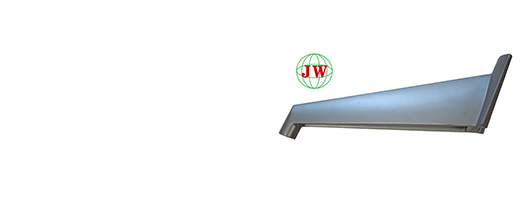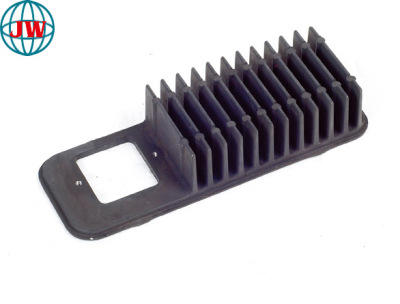
Which communication parts are made by casting?
2024-09-30 16:14
In the ever-evolving world of communication technology, the quality and performance of communication parts are of utmost importance. Casting, a manufacturing process with a long history, has found significant applications in the production of these essential components. This article will explore which communication parts are made by casting and the role of casting and communication die casting parts in the communication industry.
Casting is a process in which molten metal or other materials are poured into a mold to form a specific shape. This method offers several advantages for the production of communication parts. Firstly, it allows for the creation of complex geometries that may be difficult or impossible to achieve through other manufacturing methods. Secondly, casting can produce parts with high precision and tight tolerances, ensuring proper fit and function. Finally, casting is a cost-effective solution for high-volume production, making it an ideal choice for the communication industry where large quantities of parts are often required.
One of the most common communication die casting parts is the housing or enclosure for communication devices. These housings need to be strong, durable, and able to protect the internal components from external factors such as impact, moisture, and electromagnetic interference. Die casting of aluminum or zinc alloys is often used to create these housings due to their excellent mechanical properties and corrosion resistance. The process allows for the production of thin-walled yet sturdy housings with intricate designs and tight tolerances.
For example, the housing of a mobile phone is typically made by die casting. The lightweight aluminum or zinc alloy housing provides protection to the sensitive electronic components inside while also adding to the aesthetic appeal of the device. The die casting process can create complex shapes and textures on the housing, allowing for unique designs and branding opportunities.
Another important communication part made by casting is the antenna base or mount. Antennas are crucial components of communication systems as they are responsible for transmitting and receiving signals. The performance of an antenna depends on a stable and reliable mounting structure. Casting can produce antenna bases with precise dimensions and complex geometries, ensuring optimal signal reception and transmission.
Die casting of magnesium alloys is often used for antenna bases due to their lightweight and high strength-to-weight ratio. The process allows for the creation of intricate designs that can accommodate multiple antennas and other components. Additionally, the corrosion resistance of magnesium alloys makes them suitable for outdoor applications.
Connectors and plugs are also frequently made by casting. These communication parts need to have accurate dimensions and smooth surfaces to ensure proper mating and reliable electrical connections. Casting can produce connectors with tight tolerances and complex shapes, enabling efficient signal transmission.
Die casting of brass or copper alloys is commonly used for high-quality connectors. The excellent electrical conductivity of these materials ensures low signal loss and interference. The casting process can also incorporate features such as locking mechanisms and strain reliefs to enhance the durability and reliability of the connectors.
In addition to these parts, casting is also used to manufacture heat sinks for communication devices. Heat sinks are essential for dissipating heat generated by the electronic components, ensuring proper operation and longevity. Casting can produce heat sinks with complex fin geometries and high surface area-to-volume ratios, maximizing heat transfer efficiency.
Die casting of aluminum alloys is often used for heat sinks due to their good thermal conductivity and lightweight nature. The process allows for the creation of intricate fin designs that can effectively transfer heat away from the components. Additionally, the corrosion resistance of aluminum alloys makes them suitable for use in various environments.
The benefits of using casting for the production of communication parts extend beyond the ability to create complex shapes and tight tolerances. Casting also offers cost savings in terms of material usage and production efficiency. The process can utilize recycled materials, reducing the environmental impact and cost of raw materials. Additionally, casting can be automated to a large extent, reducing labor costs and increasing production speed.
Furthermore, casting allows for the integration of multiple functions into a single part. For example, a housing can be designed with built-in heat sinks, connectors, and mounting features, reducing the overall part count and assembly complexity. This integration can improve the reliability and performance of the communication device.
In conclusion, casting plays a vital role in the production of communication parts. From housings and antenna bases to connectors and heat sinks, casting and communication die casting parts offer numerous advantages in terms of design flexibility, precision, and cost-effectiveness. As the communication industry continues to evolve, casting will remain an important manufacturing process for ensuring the quality and performance of communication parts
Related News
More >-
![Low-Carbon Tech & AI: The Dual Engines Powering Aluminum Die-Casting Mold Industry Growth]()
Low-Carbon Tech & AI: The Dual Engines Powering Aluminum Die-Casting Mold Industry Growth
Frankfurt, Nov. 3, 2025 – The global aluminum die-casting mold market, set to hit $120B by 2030, is driven by low-carbon tech and AI. Stricter rules (EU New Green Deal, China’s “Dual Carbon”) push recycled alloy molds (38% of production now, up from 19% in 2020), cutting CO₂ by 42%. AI-optimized molds with IoT sensors reduce downtime by 28% and defects to 0.3%, while digital twins slash development time by 40%. EV demand boosts mega-casting molds (2m+ parts), cutting vehicle weight by 15-20%. Challenges like SME tech access and 25% technician shortage exist, but training programs aim to address gaps, with the sector poised for innovation-led growth.
-
![Asia-Pacific Leads Global Die-Casting Expansion: New Markets, Cross-Industry Use Cases, and Policy Support Drive Growth]()
Asia-Pacific Leads Global Die-Casting Expansion: New Markets, Cross-Industry Use Cases, and Policy Support Drive Growth
The die-casting industry sees APAC as its core growth driver, holding 70% of global production. Valued at 55Bin2024,APAC’smarketissettohit 82B by 2030 (7.2% CAGR). China dominates (58% of APAC output) via EV demand for large-format die-casting molds, while SE Asia (Vietnam, Thailand) and India gain traction with investments and policies like “Make in India.” Beyond automotive, die-cast components serve power electronics (e.g., Huawei’s 5G heat sinks) and renewables (Adani’s solar enclosures). APAC policies (China’s “Dual Carbon,” India’s green hydrogen mission) push sustainability. Challenges like H13 steel shortages exist, but “local for local” manufacturing and low-carbon alloys offer opportunities
-
![Die-Casting Industry’s Dual Breakthroughs: Surging Demand for Die-Cast Components Drives Die-Casting Mold Innovation]()
Die-Casting Industry’s Dual Breakthroughs: Surging Demand for Die-Cast Components Drives Die-Casting Mold Innovation
In 2025, the global die-casting industry enjoys dual dividends of "demand explosion" and "technological iteration." New energy vehicles (NEVs) and other sectors drive the die-cast components market to exceed $320 billion, while die-casting molds upgrade via AI and new materials. NEVs use over 50kg of die-cast components per vehicle; Tesla’s Model Y integrated die-castings boost efficiency, and LK Group launches 9,000-ton die-casting machines with supporting molds. Mold tech breaks through in materials (ceramic-coated steel, composite molds) and intelligence (AI design systems). Green manufacturing also gains traction. By 2030, the integrated die-cast components market is expected to surpass $80 billion, with the "intelligence + green" path fueling industry growth.
-
![Aluminum Furniture Connectors: How Die-Casting Molds & Alloy Components Elevate Modern Home Design]()
Aluminum Furniture Connectors: How Die-Casting Molds & Alloy Components Elevate Modern Home Design
Aluminum furniture connectors revolutionize furniture manufacturing, solving instability/rust issues. Powered by aluminum alloy die-castings (ADC12/A380, 60% lighter than steel, 5x more impact-resistant than plastic) and precise die-casting molds (H13 steel, ±0.03mm tolerance), they enable durable modular furniture. 3D-printed mold inserts cut production time by 25%, while 70% of brands use recycled aluminum in connectors for sustainability. The $1.2B 2023 market will hit $1.8B by 2030 (Asia-Pacific leading). Future trends include sensor-equipped connectors and AI-powered molds, with nanocoatings boosting durability.
-
![Aluminum Die-Castings: Powering Innovation Across Industries with Precision and Versatility]()
Aluminum Die-Castings: Powering Innovation Across Industries with Precision and Versatility
Aluminum die-castings are pivotal in modern manufacturing, spanning automotive, aerospace, construction, and electronics. Produced via high-pressure injection of molten aluminum alloys (e.g., ADC12, A380) into steel molds, they offer tight tolerances (±0.02mm), strength, lightness, and corrosion resistance. Their design flexibility integrates multiple features, cutting costs. Used in EV parts, aircraft components, and electronics, they drive efficiency. The $78B 2023 market grows 7.5% yearly, fueled by EVs and renewables. With 3D printing and AI advancing production, plus high recyclability, they’re key to sustainable innovation.
-
![Aluminum Alloy Automotive Die-Casting Parts: Driving the Future of Lightweight Mobility]()
Aluminum Alloy Automotive Die-Casting Parts: Driving the Future of Lightweight Mobility
Aluminum alloy automotive die-casting parts are pivotal in automotive innovation, balancing performance, efficiency, and sustainability. Replacing steel, they cut vehicle weight (a 10% reduction boosts fuel efficiency by 6–8%), critical for emissions goals. Made via high-pressure die-casting with alloys like A380, these parts offer complex geometries, 320 MPa strength (60% lighter than steel), and cost savings. Used in EV batteries, chassis, and powertrains, they aid brands like Tesla and BYD. The $58B 2023 market grows 8.5% yearly, driven by EVs. With 3D printing and AI advancing production, and 100% recyclability, they shape the future of lightweight, eco-friendly mobility.
-
![Aluminum Furniture Die Castings: How Molds and Components Shape Modern Design]()
Aluminum Furniture Die Castings: How Molds and Components Shape Modern Design
Aluminum die castings and die casting molds are transforming furniture manufacturing, merging precision, strength, and sustainability. Molds—crafted from hardened steel using CAD and 3D modeling—produce consistent, intricate castings with tight tolerances, enabling complex designs like curved chair legs or modular frames. Castings offer lightweight durability (200–300 MPa tensile strength), corrosion resistance, and recyclability, ideal for indoor/outdoor use. Innovations like 3D-printed mold inserts and smart sensors boost efficiency, while demand grows (5.8% annual market growth). Despite high initial mold costs, their longevity and low per-unit costs drive adoption, making them key to modern, eco-friendly furniture design.
-
![Die-Cast Lighting: Technological Innovation Illuminates the New Era of Green Lighting]()
Die-Cast Lighting: Technological Innovation Illuminates the New Era of Green Lighting
Die-cast lighting is reshaping the industry with technological advancements. Its precision die-casting enables seamless, complex designs, using aluminum, magnesium, and zinc alloys for durability and aesthetics. Intelligent manufacturing, via digital workshops and 3D simulation, boosts quality and efficiency. Green efforts include recycled materials and high recyclability. Market trends favor customization and functional integration like sensors. With 5G IoT and AI, it will advance intelligent, sustainable lighting.
Get the latest price? We'll respond as soon as possible(within 12 hours)












